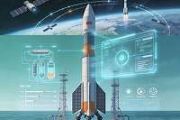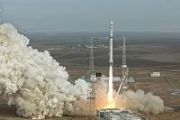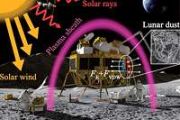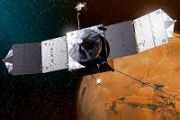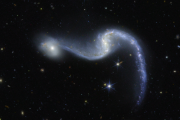
Copernical Team
These sounds are out of this world
 You may know how other planets look, like the rust orange, dusty surface of Mars or the vibrant teal of Uranus. But what do those planets sound like?
Timothy G. Leighton from the University of Southampton in the U.K. designed a software program that produces extraterrestrial environmental sounds and predicts how human voices might change in distant worlds. He will demonstrate his work at t
You may know how other planets look, like the rust orange, dusty surface of Mars or the vibrant teal of Uranus. But what do those planets sound like?
Timothy G. Leighton from the University of Southampton in the U.K. designed a software program that produces extraterrestrial environmental sounds and predicts how human voices might change in distant worlds. He will demonstrate his work at t Perseverance images may show record of wild Martian river
 Evidence left in rocks is leading scientists to rethink what watery environments looked like on ancient Mars.
New images taken by NASA's Perseverance rover may show signs of what was once a rollicking river on Mars, one that was deeper and faster-moving than scientists have ever seen evidence for in the past. The river was part of a network of waterways that flowed into Jezero Crater, the
Evidence left in rocks is leading scientists to rethink what watery environments looked like on ancient Mars.
New images taken by NASA's Perseverance rover may show signs of what was once a rollicking river on Mars, one that was deeper and faster-moving than scientists have ever seen evidence for in the past. The river was part of a network of waterways that flowed into Jezero Crater, the NASA selects five teams to study Lunar science and sample analysis
 NASA has selected five new research teams to collaborate on lunar science and lunar sample analysis research to support future exploration of the Moon as part of the agency's Solar System Exploration Research Virtual Institute (SSERVI).
"These new teams will collaborate with the existing SSERVI teams to maintain NASA's leadership in lunar science in this new era of lunar exploration," said
NASA has selected five new research teams to collaborate on lunar science and lunar sample analysis research to support future exploration of the Moon as part of the agency's Solar System Exploration Research Virtual Institute (SSERVI).
"These new teams will collaborate with the existing SSERVI teams to maintain NASA's leadership in lunar science in this new era of lunar exploration," said Wenchang Spacecraft Launch Site can launch new-generation rockets
 The Wenchang Spacecraft Launch Site in south China's Hainan Province is already capable of high-density launch of new-generation large and medium-sized carrier rockets.
Since the launch site was established, it has conducted many major space launch missions, including the maiden flight of China's new-generation high-thrust carrier rockets, China's first planetary exploration, and the const
The Wenchang Spacecraft Launch Site in south China's Hainan Province is already capable of high-density launch of new-generation large and medium-sized carrier rockets.
Since the launch site was established, it has conducted many major space launch missions, including the maiden flight of China's new-generation high-thrust carrier rockets, China's first planetary exploration, and the const Populous engaged by RS&H for New Mexico's Spaceport America Master Plan
 The New Mexico Spaceport Authority (NMSA) has awarded the Spaceport America Master Plan Project to the RS&H team, with Populous and Zia Engineering and Environmental Consultants respectively leading key aspects of the future visioning and environmental stewardship critical to the project. Spaceport America and NMSA will partner with the team to identify the current and future market opportunitie
The New Mexico Spaceport Authority (NMSA) has awarded the Spaceport America Master Plan Project to the RS&H team, with Populous and Zia Engineering and Environmental Consultants respectively leading key aspects of the future visioning and environmental stewardship critical to the project. Spaceport America and NMSA will partner with the team to identify the current and future market opportunitie Imaging satellite takes piggyback ride on spacecraft
 The first satellite designed and built in China's northeastern province of Liaoning has been carried into space by the Tianzhou 6 cargo spacecraft, which was launched on Wednesday night, according to the Dalian University of Technology.
Developed by the university in the coastal city of Dalian, the Dalian 1-Lianli is a 17-kilogram mini Earth-observation satellite and is tasked with demonst
The first satellite designed and built in China's northeastern province of Liaoning has been carried into space by the Tianzhou 6 cargo spacecraft, which was launched on Wednesday night, according to the Dalian University of Technology.
Developed by the university in the coastal city of Dalian, the Dalian 1-Lianli is a 17-kilogram mini Earth-observation satellite and is tasked with demonst Upcoming ISS project will test 3D materials for satellite manufacturing
 As 3D printed rockets, car parts, and even homes begin to hit the market on Earth, L3Harris Technologies aims to leverage the International Space Station (ISS) National Laboratory in its search for durable materials to 3D print satellite components. Before 3D printed materials can be used to build more sustainable and efficient parts for spacecraft, they must be tested to ensure they can withsta
As 3D printed rockets, car parts, and even homes begin to hit the market on Earth, L3Harris Technologies aims to leverage the International Space Station (ISS) National Laboratory in its search for durable materials to 3D print satellite components. Before 3D printed materials can be used to build more sustainable and efficient parts for spacecraft, they must be tested to ensure they can withsta NASA and partners achieve fastest space-to-ground laser comms link
 On April 28, NASA and its partners achieved another major milestone in the future of space communications - achieving 200 gigabit per second (Gbps) throughput on a space-to-ground optical link between a satellite in orbit and Earth, the highest data rate ever achieved by optical communications technology.
These data rates are made possible by using laser communications, which packs informa
On April 28, NASA and its partners achieved another major milestone in the future of space communications - achieving 200 gigabit per second (Gbps) throughput on a space-to-ground optical link between a satellite in orbit and Earth, the highest data rate ever achieved by optical communications technology.
These data rates are made possible by using laser communications, which packs informa Sidus Space selected by OneWeb to manufacture satellite hardware
 Sidus Space, Inc. (NASDAQ:SIDU), a leading provider of machined parts to the global space industry, has been selected by Airbus OneWeb Satellites, LLC (AOS) to design and build machined parts. The machined parts will be integrated into the portfolio of Arrow commercial small satellites manufactured by AOS.
Airbus OneWeb Satellites LLC is a joint venture between Airbus and OneWeb. AOS manuf
Sidus Space, Inc. (NASDAQ:SIDU), a leading provider of machined parts to the global space industry, has been selected by Airbus OneWeb Satellites, LLC (AOS) to design and build machined parts. The machined parts will be integrated into the portfolio of Arrow commercial small satellites manufactured by AOS.
Airbus OneWeb Satellites LLC is a joint venture between Airbus and OneWeb. AOS manuf USAF awards contract to Above: Orbital and Ascent Solar for on-orbit PV production
 Above: Orbital, Inc. has been awarded a significant contract from the United States Air Force for On-orbit Manufacturing of Thin-Film Solar Photovoltaics in partnership with Ascent Solar Technologies, Inc. (NASDAQ: ASTI), the leading U.S. innovator in the design and manufacture of featherweight, flexible, and durable CIGS thin-film photovoltaic (PV) solutions.
The Small Business Innovation
Above: Orbital, Inc. has been awarded a significant contract from the United States Air Force for On-orbit Manufacturing of Thin-Film Solar Photovoltaics in partnership with Ascent Solar Technologies, Inc. (NASDAQ: ASTI), the leading U.S. innovator in the design and manufacture of featherweight, flexible, and durable CIGS thin-film photovoltaic (PV) solutions.
The Small Business Innovation 



